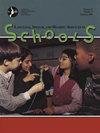Universal Trauma Screening in Preschool Speech and Language Services: Screening Process and Client Profiles.
IF 2.9
3区 医学
Q1 AUDIOLOGY & SPEECH-LANGUAGE PATHOLOGY
Language Speech and Hearing Services in Schools
Pub Date : 2025-09-17
DOI:10.1044/2025_lshss-24-00144
引用次数: 0
Abstract
PURPOSE The purpose of this study was to investigate the implementation of universal trauma screening in publicly funded preschool speech and language (PSL) services. This article presents the results pertaining to the screening process and the client profiles of research participants (including trauma exposures and potential responses). METHOD As part of a larger study, a clinical pilot and research study were undertaken. The clinical pilot included the design and implementation of a screening protocol where speech-language pathologists prescreened clients for potential trauma exposure during initial assessment, and then offered families a full trauma screening with a mental health professional. Data were collected from 193 speech-language pathologist-completed questionnaires following initial assessment and from the full trauma screenings of 57 children aged 9-50 months (which comprised the research study). RESULTS During PSL initial assessments, 30% of clients disclosed potential trauma exposure. The highest reported exposures included public health or environmental crises (33%), major family moves (30%), and significant separations from parents/caregivers or close family members (26%). Of the top seven reported exposures, four were characterized as interpersonal trauma, and 35% of clients reported at least three trauma exposures. A significant correlation was observed between the number of reported trauma exposures and potential trauma responses, which are commonly seen in PSL services, r(55) = .28, p = .037. CONCLUSIONS The findings highlight the importance of integrating trauma-informed care universally in PSL services, including collaborative speech-language pathology and mental health services. Universal trauma screening in PSL services can identify at-risk children early, allowing for tailored interventions and better support for families. The study underscores the need for integrated services to address the complex needs of children exposed to trauma.学前言语和语言服务的普遍创伤筛查:筛选过程和客户档案。
目的本研究的目的是调查公共资助的学前言语和语言(PSL)服务中普遍创伤筛查的实施情况。本文介绍了有关筛选过程的结果和研究参与者的客户概况(包括创伤暴露和潜在反应)。方法作为一项大型研究的一部分,进行了临床试验和研究研究。临床试验包括设计和实施一项筛查协议,在该协议中,语言病理学家在初步评估期间预先筛选客户潜在的创伤暴露,然后向家庭提供由心理健康专业人员进行的全面创伤筛查。数据来自193名语言病理学家在初步评估后完成的问卷调查,以及57名9-50个月大的儿童(包括研究研究)的全面创伤筛查。结果在PSL的初步评估中,30%的患者透露了潜在的创伤暴露。报告的最高暴露包括公共卫生或环境危机(33%)、重大家庭搬家(30%)以及与父母/照顾者或亲密家庭成员的重大分离(26%)。在报告的前七种暴露中,有四种被描述为人际创伤,35%的客户报告至少有三种创伤暴露。报告的创伤暴露次数与潜在的创伤反应之间存在显著的相关性,这在PSL服务中很常见,r(55) = 0.28, p = 0.037。结论研究结果强调了在PSL服务中普遍整合创伤知情护理的重要性,包括协同语言病理学和心理健康服务。PSL服务中的普遍创伤筛查可以及早发现有风险的儿童,从而进行有针对性的干预并为家庭提供更好的支持。该研究强调需要提供综合服务,以解决遭受创伤的儿童的复杂需求。
本文章由计算机程序翻译,如有差异,请以英文原文为准。
求助全文
约1分钟内获得全文
求助全文
来源期刊

Language Speech and Hearing Services in Schools
Social Sciences-Linguistics and Language
CiteScore
4.40
自引率
12.50%
发文量
165
期刊介绍:
Mission: LSHSS publishes peer-reviewed research and other scholarly articles pertaining to the practice of audiology and speech-language pathology in the schools, focusing on children and adolescents. The journal is an international outlet for clinical research and is designed to promote development and analysis of approaches concerning the delivery of services to the school-aged population. LSHSS seeks to advance evidence-based practice by disseminating the results of new studies as well as providing a forum for critical reviews and meta-analyses of previously published work.
Scope: The broad field of audiology and speech-language pathology as practiced in schools, including aural rehabilitation; augmentative and alternative communication; childhood apraxia of speech; classroom acoustics; cognitive impairment; craniofacial disorders; fluency disorders; hearing-assistive technology; language disorders; literacy disorders including reading, writing, and spelling; motor speech disorders; speech sound disorders; swallowing, dysphagia, and feeding disorders; voice disorders.
 求助内容:
求助内容: 应助结果提醒方式:
应助结果提醒方式:


